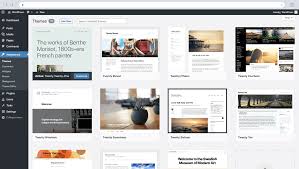Introduction to WordPress
WordPress is one of the most popular content management systems (CMS) in the world, powering millions of websites across various industries. Originally launched in 2003 as a blogging platform, it has evolved into a versatile CMS that allows users to create websites, blogs, online stores, and more without requiring extensive coding knowledge.
Why Choose WordPress?
- User-Friendly Interface WordPress offers an intuitive dashboard that makes it easy for beginners and experienced developers alike to manage their websites efficiently. With its simple navigation, users can quickly publish content, customize layouts, and manage site settings.
- Flexibility and Customization With thousands of free and premium themes and plugins available, WordPress provides endless customization options. Whether you need a business website, an eCommerce store, a portfolio, or a blog, you can tailor WordPress to suit your needs.
- SEO-Friendly WordPress is designed with SEO best practices in mind. It allows for easy optimization of content, meta descriptions, and URLs, helping websites rank higher on search engine results pages. Popular SEO plugins like Yoast SEO and Rank Math further enhance search engine visibility.
- Strong Community Support As an open-source platform, WordPress benefits from a vast community of developers, designers, and users who contribute to its continuous improvement. There are extensive resources, including forums, tutorials, and documentation, making troubleshooting and learning easier.
- Security and Regular Updates WordPress provides regular updates to address security vulnerabilities and improve performance. Additionally, users can install security plugins such as Wordfence and Sucuri to enhance website protection.
- E-commerce Capabilities With plugins like WooCommerce, WordPress enables users to set up fully functional online stores. WooCommerce supports payment gateways, inventory management, and customizable product pages, making it a preferred choice for eCommerce websites.
Getting Started with WordPress
- Choose a Hosting Provider To use WordPress, you need a domain name and hosting service. Popular hosting providers include Bluehost, SiteGround, and WP Engine, offering one-click WordPress installation.
- Install WordPress Most hosting providers offer automated WordPress installation. Alternatively, users can download and install WordPress manually from the official website (wordpress.org).
- Select a Theme Choose a theme from the WordPress repository or third-party marketplaces like ThemeForest. Themes control the overall look and feel of the website.
- Install Essential Plugins Enhance website functionality with plugins such as:
- Yoast SEO (SEO optimization)
- Elementor (Page builder)
- WooCommerce (eCommerce functionality)
- UpdraftPlus (Backup solution)
- WP Rocket (Speed optimization)
- Create and Publish Content Use the WordPress editor to create pages and posts. Utilize categories and tags to organize content effectively.
- Optimize and Maintain Regularly update WordPress, themes, and plugins to ensure security and performance. Use analytics tools like Google Analytics to monitor traffic and optimize website performance.
Conclusion
WordPress is a powerful and flexible CMS suitable for individuals, businesses, and organizations looking to establish an online presence. With its ease of use, extensive customization options, and strong community support, it remains the top choice for website development. Whether you’re a beginner or an experienced developer, WordPress provides the tools necessary to create a professional and functional website.






